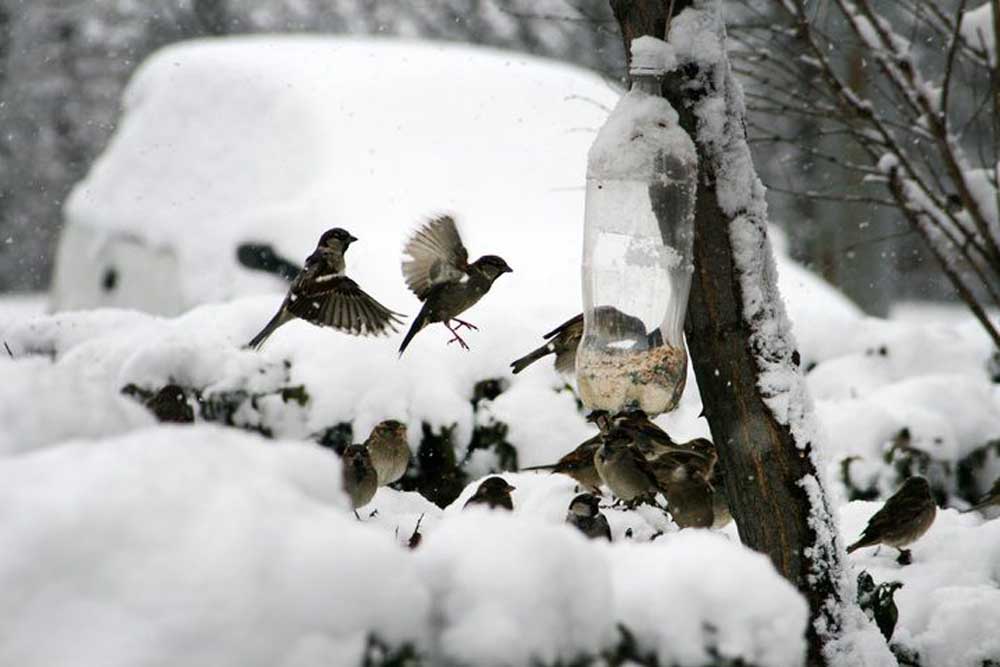Snack attacks for our feathered friends. Backyard birds can use a little help during winter.
Published 8:00 am Tuesday, January 1, 2019

- Feeders help birds get through the coldest months. (Courtesy)
This is the season for feeding birds in backyards. During most of the year, birds have ample food sources in nature. However, during winter, when their food becomes scarcer, birds sometimes can use a little help.
This is where bird lovers come in. Putting out feeders full of seeds and other types of food help birds endure the coldest months.
FEEDERS
Either buy a bird feeder or make your own. Any container that holds food, is easily accessible to birds and has good drainage will work.
A straw hat with the brims pulled up with wire or a pie pan with small drainage holes snuggled inside a hanging planter can be a feeder.
Even poking sunflower seeds into peanut butter spread on a tree branch becomes a food source. Birds easily are pleased as long as the food is good for them.
BIRD FOOD
Black-oil sunflower seed: Almost any bird that visits a feeder will eat black-oil sunflower seeds. The outer shell is thin and easy to crack. Birds that cannot crack the shell will scour the ground below the feeder for fallen seeds. The large kernel inside the shell gives birds a lot of nutrition.
Peanuts: Woodpeckers, jays, nuthatches, chickadees and titmice love peanuts, a high-protein food source. The peanuts must be unsalted and shelled. Packages of peanut bits are available at some stores.
Thistle seed: Small finches eat thistle seed, or nyjer. Thistle seed is best served in a special feeder – commonly a tube feeder or sock with tiny holes. Finches cling to the feeder and pull the little seeds out. If you use a sock as a feeder, make sure to keep it clean and dry.
Safflower seed: Most birds, especially doves and cardinals, like safflower, a white, thin-shelled seed. Safflower seeds can be mixed in with sunflower seeds. Don’t sprinkle safflower seeds on the ground because they quickly become soggy.
Cracked corn: Cracked corn attracts birds, squirrels, deer and raccoons. Some use cracked corn to lure squirrels away from bird feeders. Don’t use whole ears of corn because the kernels are too big and hard for most birds to digest. Instead, break cracked corn into small pieces.
Fresh fruit: Grapes, berries, oranges, apples and melon rind are important ingredients in a bird’s diet. It is not good to put out fruit during warm weather because it draws flies, mosquitoes and bees. Be careful not to put out fruit during freezing temperatures. Soak dried fruit in warm water to soften them so the birds can digest them more easily.
Suet: During winter, birds need fat as a source of energy. Suet is rendered fat that is usually mixed with seeds, bits of fruit and nuts. Suet is an important source of winter food for woodpeckers and wrens. Packages of suet bird treats are sold in stores.
Mixed seed: There is debate about whether to put out mixed-seed products. Often, fillers such as wheat, dyed seeds and red milo are put in the mixture. Some birds push out the unwanted food to get to the good stuff. Read bird seed labels carefully for the ingredients.
MAKE BIRD TREATS
“Cooking for the Birds,” which is published by Adventure Publications, has easy-to-make recipes for bird food, including the following.
Double-dipped Cone: Tie a 12-inch length of string just under the stem of a pine cone. Melt suet at a low heat in a saucepan. Hold the string and dip the cone into the suet.
Place the dipped cone on wax paper and immediately sprinkle seeds over it. Let the cone cool slightly and then place it in the refrigerator. When the cone cools, melt peanut butter in the microwave oven. Drizzle the melted peanut butter over the cone.
When it is cool, hang your bird feast in the yard and watch the birds dig in.
Raisin-berry Relish: This is a favorite snack of cardinals and cedar waxwings. You need a couple of oranges (or about a ½-cup of orange juice), 1 cup of raisins, 1 10-ounce package of frozen cranberries and 1 cup of brown sugar.
Cut the oranges in half and squeeze their juice over the fruit and sugar. Save the orange rinds.
Heat the fruit mixture on medium heat until it bubbles. Turn down the heat and simmer for 30 minutes. When the mixture cools, fill the orange rinds (or if orange juice was used fill muffin tins).
Chopped apples and nuts can be added to the cooled mixture.
Suet-sicles: For this finch, chickadee and nuthatch delicacy, you need 3 cups of suet, 1 cup of thistle seed, ice pop molds, craft sticks with holes and string.
Melt the suet in the microwave oven. Use the mixture to fill the molds up to 1 inch and sprinkle on a thin layer of seeds.
Refrigerate the mixture in the molds until it becomes slightly hardened. Place a stick in the molds and freeze. Thread string through the holes in the sticks, pop the frozen mixture from the molds and hang them from a tree limb.
Ann Bush is an East Texas based freelance writer who loves birds.






